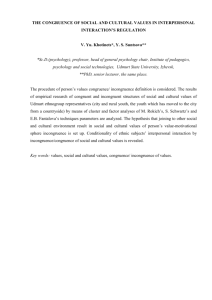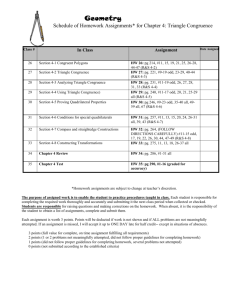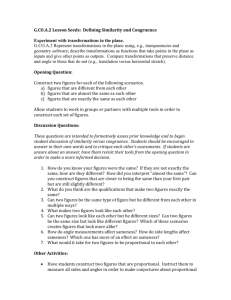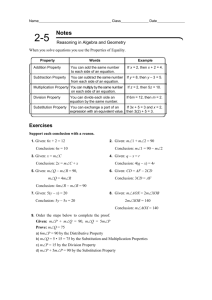online appendix
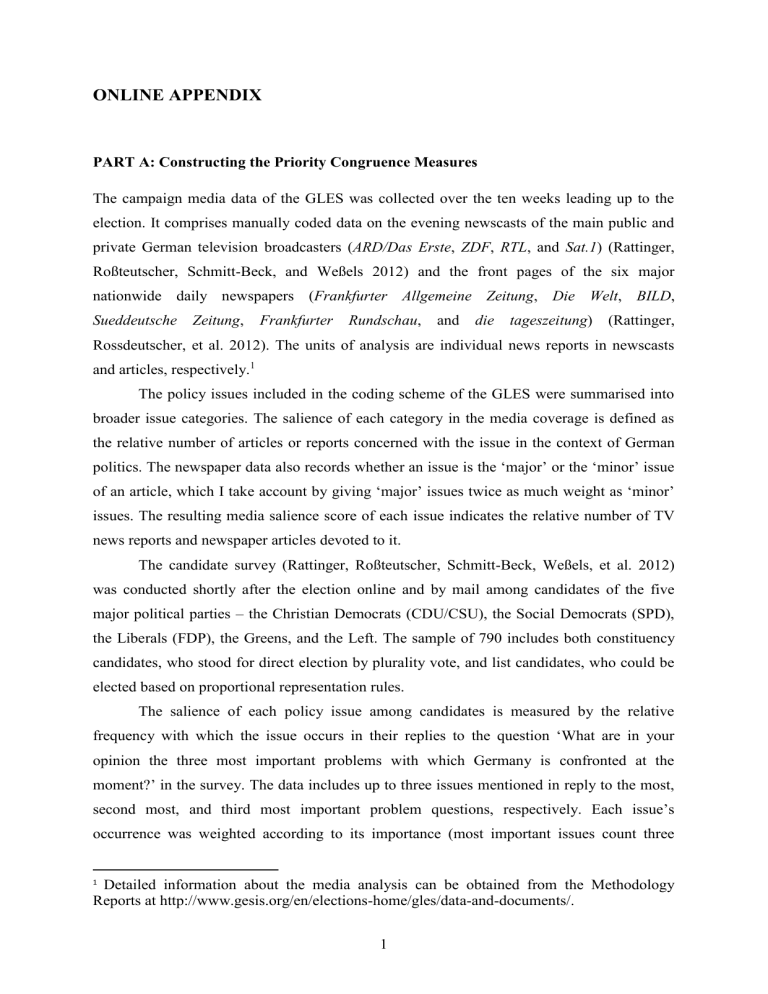
ONLINE APPENDIX
PART A: Constructing the Priority Congruence Measures
The campaign media data of the GLES was collected over the ten weeks leading up to the election. It comprises manually coded data on the evening newscasts of the main public and private German television broadcasters ( ARD/Das Erste , ZDF , RTL , and Sat.1
Roßteutscher, Schmitt-Beck, and Weßels 2012) and the front pages of the six major
nationwide daily newspapers ( Frankfurter Allgemeine Zeitung , Die Welt , BILD ,
Sueddeutsche Zeitung , Frankfurter Rundschau , and die tageszeitung
Rossdeutscher, et al. 2012). The units of analysis are individual news reports in newscasts
and articles, respectively.
1
The policy issues included in the coding scheme of the GLES were summarised into broader issue categories. The salience of each category in the media coverage is defined as the relative number of articles or reports concerned with the issue in the context of German politics. The newspaper data also records whether an issue is the ‘major’ or the ‘minor’ issue of an article, which I take account by giving ‘major’ issues twice as much weight as ‘minor’ issues. The resulting media salience score of each issue indicates the relative number of TV news reports and newspaper articles devoted to it.
The candidate survey (Rattinger, Roßteutscher, Schmitt-Beck, Weßels, et al. 2012)
was conducted shortly after the election online and by mail among candidates of the five major political parties – the Christian Democrats (CDU/CSU), the Social Democrats (SPD), the Liberals (FDP), the Greens, and the Left. The sample of 790 includes both constituency candidates, who stood for direct election by plurality vote, and list candidates, who could be elected based on proportional representation rules.
The salience of each policy issue among candidates is measured by the relative frequency with which the issue occurs in their replies to the question ‘What are in your opinion the three most important problems with which Germany is confronted at the moment?’ in the survey. The data includes up to three issues mentioned in reply to the most, second most, and third most important problem questions, respectively. Each issue’s occurrence was weighted according to its importance (most important issues count three
1 Detailed information about the media analysis can be obtained from the Methodology
Reports at http://www.gesis.org/en/elections-home/gles/data-and-documents/.
1
times and second most important issues twice as much as third most important issues). In order construct the dyadic congruence measure, issue salience scores were calculated for each party separately.
In the next step, I calculate the priority congruence scores of each respondent in the post-election cross-sectional voter survey, which was conducted within eight weeks after the
election (Rattinger et al. 2011). Similarly to the candidates, voters were asked what they
thought were the most, second most, and third most important problems facing Germany at the moment. From each of the three responses, up to five issue categories are listed in the data set, in cases where a respondent included more than one issue in her response.
Respondents’ congruence scores were calculated by averaging the salience of their concerns among candidates and the media, respectively.
2
If respondents mentioned multiple issues in one response, these partial congruence scores were averaged. Each respondent’s three resulting congruence scores, for the most, second most, and third most important problems, were then combined into a weighted average, where the most important issue(s) again counts three times as much as the third most important issue(s) and the second most important issue(s) twice as much.
3
Dyadic priority congruence indicates how salient a respondent’s concerns were among the candidates of the party for which he or she declared to have voted, if any. Since
Germany has a mixed-member proportional election system and voters can make two crosses
– one for a constituency candidate and one for a party list – I take the average congruence with both parties when respondents split their ticket.
4
Collective priority congruence is constructed by averaging the five major parties’ salience levels of a respondent’s priorities, weighted by parties’ seat shares after the election as a proxy for their visibility. Figure OA1 shows the distributions of the three priority congruence variables.
2
I constructed separate TV congruence and print media congruence variables, yet they were so highly correlated (Pearson’s r = .97. p<.0005) that it makes sense to average them.
3 In Part B of this Online Appendix, I further discuss the rationale behind the weighting scheme and apply two alternative specifications.
4
Since strategic voting occurs with respect to both votes, it is difficult to tell which party reflects a voter’s ‘true’ preference (Gschwend 2007).
2
Figure OA1. Distributions of the priority congruence measures
3
PART B: Testing Alternative Specifications of Priority Congruence
In the following, I explain my decision to weight citizens’ issue priorities based on whether they were mentioned as most, second most, and third most important problems. I furthermore test the robustness of the results with alternative specifications of the congruence variables.
The respondents of the voter and candidate surveys were not simply asked to provide a number of policy concerns but to express which issues facing Germany they consider most important, second most important, and third most important. If we accept the assumptions that citizens and candidates do in fact assign different levels of importance to issues; that the
‘most important problem’ (MIP) survey items capture this rank order; that issues considered more important by candidates’ are more salient in the political debate; and that the issues that citizens consider more important by citizens influence their evaluations of elites’ preferences
more strongly (cf. Krosnick 1989; Lavine et al. 1996), which should take these rank orders
into account.
In order to do so in my measures of issue salience and priority congruence, I weight candidates’ and voters’ issue mentions as follows: the second most important issues receive two thirds of the weight and the third most important issues receive one third of the weight as the most important issues. Yet, it is possible – though not likely – that the assumptions listed above are flawed and, consequently, the 3-2-1 weighting scheme is not appropriate. In particular, citizens’ rank order might not reflect their actual attitudes, whereas candidates should have spent considerable effort reflecting on their priorities. Thus, I empirically test the validity of the 3-2-1 weighting of citizens’ concerns. For this purpose, I replicate Models 1, 2, and 3 in Table 1 using two alternative sets of priority congruence measures.
For the first set of alternative variables, respondents’ congruence is still calculated based on the salience of their first, second, and third most important problems amongst candidates and in the media. Candidates’ priorities are, again, weighted based on the 3-2-1 scheme, but citizens’ priorities are not weighted. This variable thus reflects the possibility that citizens either have no clear rank order among their most important issue concerns or that the survey items included in the voter survey do not capture it.
The second specification is only based on respondents’ most important problem, ignoring the second and third issues. This variable reflects the view that citizens’ capacity and willingness to spend cognitive effort on political matters is limited and that they use
heuristics to form opinions and make choices (Delli Carpini and Keeter 1996; Lau and
4
Redlawsk 2001; Popkin 1991). Citizens’ evaluation of elite attention to their single most
important concern could be used as a heuristic to evaluate congruence more generally.
All three variants of the congruence variable are quite strongly correlated with each other (Table OB1). Tables OB2 and OB3 show the results of the estimations of Models 1, 2, and 3 from Table 1, with the alternative congruence variables substituting the weighted specification. In all models, priority congruence significantly (p<.05) predicts democratic satisfaction, confirming that the relationship is robust to different specifications of the explanatory variable. In Table OB4, I list the deviance values of all models in Tables 1, OB2, and OB3. None of the three different specifications of the congruence variable consistently fits the data better than the others. It thus does not seem strictly necessary to use the 3-2-1 weighting scheme that I use in the paper. Nevertheless, based on the theoretical arguments in favour of the weighted measure, I choose to use it in the paper.
Table OB1 . Correlations between different measures of priority congruence
Media congruence
Collective candidate congruence
Dyadic candidate congruence
Different weights (3-2-1) and same weights (1-1-1)
Different weights (3-2-1) and only most important problem
.96
.84
.89
.81
.90
.82
Same weights (1-1-1) and only most important problem
.67 .53 .54
Notes: Coefficients are Pearson’s r. All coefficients are statistically significant at p<.0005. N=1639 for media and collective candidate congruence, N=1124 for dyadic candidate congruence.
5
Table OB2.
The effects of priority congruence (same weights to all priorities) on satisfaction with democracy (re-estimations of models in Table 1)
Age
Female
Education
Social class
East
PID strength
Winner
Left-right distance
Redistribution distance
Immigration distance
Nuclear energy distance
Economic situation
Political interest
Newspaper use
TV news use
Media congruence
Candidate congruence
(collective)
Candidate congruence
(dyadic)
Wald chi-square
Pseudo R-squared
LR test
N
Model 1
.01 (.00)*
-.04 (.12)
.00 (.05)
.20 (.08)**
-.37 (.14)**
.26 (.05)***
.52 (.13)***
-.30 (.06)***
-.06 (.04)
-.02 (.03)
-.05 (.04)
.51 (.10)***
.19 (.07)*
.06 (.02)**
-.02 (.01)
.03 (.01)**
245.24***
.09
7.25**
1107
Model 2
.01 (.00)*
-.05 (.12)
.00 (.05)
.22 (.08)**
-.36 (.14)*
.26 (.05)***
.54 (.13)***
-.30 (.06)***
-.06 (.04)
-.01 (.03)
-.06 (.04)
.51 (.10)***
.19 (.07)**
.05 (.02)**
-.02 (.01)
.02 (.01)**
246.46***
.09
8.11*
1107
.03 (.01)***
133.01***
.08
14.51***
636
Notes : Values are log-odds from ordinal logistic regression with robust standard errors in parentheses
(standard errors are robust since weight is employed to correct for oversampling in East Germany). The likelihood-ratio (LR) test compares the fit of each model to a model excluding priority congruence
(samples not weighted). * p<.05; ** p<.01; p<.0005.
Model 3
.01 (.00)
.13 (.17)
-.05 (.07)
.29 (.10)**
-.15 (.19)
.26 (.07)***
.78 (.21)***
-.15 (.08)
.03 (.06)
.04 (.05)
-.03 (.04)
.54 (.13)***
.22 (.10)*
.00 (.03)
-.00 (.01)
6
Table OB3.
The effects of priority congruence (only first priority) on satisfaction with democracy (re-estimations of models in Table 1)
Model 4 Model 5 Model 6
Age
Female
Education
Social class
East
PID strength
Winner
Left-right distance
Redistribution distance
Immigration distance
Nuclear energy distance
Economic situation
Political interest
Newspaper use
TV news use
Media congruence
Candidate congruence
(collective)
Candidate congruence
(dyadic)
Wald chi-square
Pseudo R-squared
LR test
N
.01 (.00)*
-.07 (.12)
.00 (.05)
.21 (.08)**
-.39 (.14)**
.25 (.05)***
.52 (.13)***
-.29 (.06)***
-.06 (.04)
-.01 (.03)
-.06 (.04)
.52 (.10)***
.17 (.07)*
.05 (.02)**
-.02 (.01)
.02 (.01)**
244.28***
.09
9.53**
1107
.01 (.00)*
-.07 (.12)
.00 (.05)
.22 (.08)**
-.36 (.14)**
.24 (.05)***
.53 (.13)***
-.30 (.06)***
-.06 (.04)
-.02 (.03)
-.06 (.04)
.52 (.10)***
.19 (.07)*
.06 (.02)**
-.02 (.01)
.02 (.01)*
239.76***
.08
4.30*
1107
.01 (.00)
.11 (.17)
-.05 (.07)
.30 (.10)**
-.15 (.19)
.24 (.07)**
.79 (.21)***
-.14 (.08)
.03 (.06)
.04 (.05)
-.03 (.04)
.56 (.13)***
.23 (.10)*
.01 (.03)
-.01 (.02)
.01 (.01)*
124.77***
.08
4.59*
636
Notes : Values are log-odds from ordinal logistic regression with robust standard errors in parentheses
(standard errors are robust since weight is employed to correct for oversampling in East Germany). The likelihood-ratio (LR) test compares the fit of each model to a model excluding priority congruence
(samples not weighted). * p<.05; ** p<.01; p<.0005.
Table OB4.
Deviance of models with different versions of the priority congruence measure
Media congruence
Collective candidate congruence
Dyadic candidate congruence
Different weights (3-2-1) 2775 2777 1655
Same weights (1-1-1)
Only most important problem
2778
2774
2777
2782
1654
1665
7
PART C: Details about the dependent variable and the control variables
Label Variable construction Coding
Mean
(std. dev.)
Satisfaction with democracy
On the whole, how satisfied or not are you with the way democracy works in Germany?
Are you very satisfied, fairly satisfied, neither/nor, fairly dissatisfied or very dissatisfied?
1 = Very dissatisfied
2 = Quite dissatisfied
3 = Neither satisfied nor dissatisfied
4 = Quite satisfied
5 = Very satisfied
3.10
(1.03)
Age Age in years (16-94)
Sex 0 = male, 1 = female
Education
Subjective social class
East
Strength of party identification
Winner
Left-right distance
Redistribution distance
“What general school leaving certificate do you have?”
“There is a lot of talk about social class these days. Which of these social classes do you consider you belong to?”
1 = no degree
2 = secondary modern school
3 = intermediate school certificate
4 = National Vocational
Qualification
5 = Abitur (highest secondary school degree)
6 = tertiary education
1 = underclass
2 = working class
3 = lower middle class
4 = middle class
5 = upper middle/upper class
Place of residency
“Do you usually think of yourself as close to any particular party?”; if yes: “how strongly or weakly are you inclined to support this party […]?” (categories “very weak” and
“quite weak” are combined)
“Voted for winning party” if respondent reported to have voted for CDU/CSU or FDP with either first or second vote or reported that would have done so in the case of respondents not eligible to vote
Distance between a respondent’s own position on the left-right scale (1= left, 11 = right) and mean of the positions at which he or she places the five major parties.
Distance between a respondent’s own position on the redistribution scale (1= lower taxes/Less government spending on health, education and social benefits , 11 = more government spending on health, education and social benefits/higher taxes) and mean of the positions at which he or she places the five major parties.
0 = West Germany
1 = East Germany, incl. Berlin
1 = no ID
2 = very or quite weak
3 = moderate
4 = quite strong
5 = very strong
0 = did not vote for winning party
1 = voted for winning party
0 = no distance
…
10 = largest distance
0 = no distance
…
10 = largest distance
50.17
(18.31)
.53
(.50)
3.09
(1.36)
2.99
(.99)
.35
(.48)
2.52
(1.41)
.38
(.48)
1.71
(1.31)
2.25
(1.80)
8
[PART C CONTINUED]
Label
Immigration distance
Nuclear energy distance
Distance between a respondent’s own position on the redistribution scale (1= laws on immigration should be relaxed , 11 = laws on immigration should be tougher) and mean of the positions at which he or she places the five major parties.
Distance between a respondent’s own position on the redistribution scale (1= more nuclear power stations should be built , 11 = all nuclear power stations should be closed down today) and mean of the positions at which he or she places the five major parties.
0 = no distance
…
10 = largest distance
0 = no distance
…
10 = largest distance
Evaluation of the current economic situation
Variable construction
“Now we come to the economic situation in
Germany. How in general terms would you rate the current economic situation in
Germany?” (original five-point scale collapsed)
Coding
1 = bad
2 = neither good nor bad
3 = good
Political interest
“How interested in politics are you?”
1 = not interested at all
2 = not very interested
3 = middling
4 = quite interested
5 = very interested
Number of days per week (range:
0-24)
Newspaper use
Number of days per week on which a respondent reads a newspaper, additive
TV news use
Number of days per week on which a respondent watches a TV news program, additive
Number of days per week (range:
0-28)
Mean
(std. dev.)
2.68
(1.96)
2.37
(1.70)
1.47
(.61)
2.71
(1.03)
4.55
(3.56)
8.36
(4.84)
9
PART D: Issue Salience and Priority Congruence by Party
Figure OD1. Mean levels of collective and dyadic priority congruence across party voters
(with 95% confidence intervals)
Figure OD2 . Relative salience of issues among candidates from the different parties at the
2009 German federal election
10
PART E: The Effect of Priority Congruence with Parties Not Voted For on Satisfaction with Democracy
Age
Female
Education
Social class
East
PID strength
Winner
Left-right distance
Redistribution distance
Immigration distance
Nuclear energy distance
Economic situation
Political interest
Newspaper use
TV news use
Priority congruence with parties not voted for
Wald chi-square
Pseudo R-squared
LR test
N
.01 (.01)
.06 (.16)
-.09 (.07)
.32 (.10)**
-.09 (.17)
.35 (.06)***
.85 (.19)***
-.19 (.08)*
-.01 (.05)
.00 (.05)
-.07 (.05)
.61 (.13)***
.14 (.09)
.02 (.02)
-.02 (.02)
.04 (.01)**
156.71***
.09
13.91***
636
Notes : Values are log-odds from ordinal logistic regression with robust standard errors in parentheses (standard errors are robust since weight is employed to correct for oversampling in East Germany).
* p<.05; ** p<.01; p<.0005.
11
References
Delli Carpini, Michael X., and Scott Keeter. 1996. What Americans Know about Politics and
Why it Matters . New Haven: Yale University Press.
Gschwend, Thomas. 2007. Ticket-Splitting and Strategic Voting under Mixed Electoral
Rules: Evidence from Germany. European Journal of Political Research 46(1): 1-23.
Krosnick, Jon A. 1989. Attitude Importance and Attitude Accessibility. Personality and
Social Psychology Bulletin 15(3): 297-308.
Lau, Richard R., and David P. Redlawsk. 2001. Advantages and Disadvantages of Cognitive
Heuristics in Political Decision Making. American Journal of Political Science 45(4):
951-971.
Lavine, Howard, John L. Sullivan, Eugene Borgida, and Cynthia J. Thomsen. 1996. The
Relationship of National and Personal Issue Salience to Attitude Accessibility on
Foreign and Domestic Policy Issues. Political Psychology 17(2): 293-316.
Popkin, Samuel L. 1991. The Reasoning Voter: Communication and Persuasion in
Presidential Campaigns . Chicago University of Chicago Press.
Rattinger, Hans, Sigrid Rossdeutscher, Ruediger Schmitt-Beck, and Bernhard Wessels. 2012.
"Campaign Media Content Analysis, Print Media (GLES 2009)." In, ed. GESIS Data
Archive. Cologne.
Rattinger, Hans, Sigrid Roßteutscher, Rüdiger Schmitt-Beck, and Bernhard Weßels. 2011.
"Post-election Cross Section (GLES 2009)." In, ed. GESIS Data Archive. Cologne.
Rattinger, Hans, Sigrid Roßteutscher, Rüdiger Schmitt-Beck, and Bernhard Weßels. 2012.
"Campaign Media Content Analysis, TV (GLES 2009)." In, ed. GESIS Data Archive.
Cologne.
Rattinger, Hans, Sigrid Roßteutscher, Rüdiger Schmitt-Beck, Bernhard Weßels, Thomas
Gschwend, Hermann Schmitt, Andreas Wüst, and Thomas Zittel. 2012. "Candidate
Campaign Survey, Survey (GLES 2009)." In, ed. GESIS Data Archive. Cologne.
12




